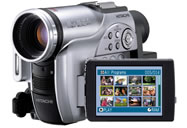Key Features.
- Retrieves VOB files (DVD Video object files) on the DVDs that were not properly finalized by Hitachi, Panasonic, Sony, Samsung, Canon and other DVD camcorders. For example, you lost an access to the video clips due to the "Disk Error" message when you turned on the camera, or disc finalization was accidently interrupted.
- Extracts VOB files off non-finalized discs, created by standalone DVD recorders (Lite-On, Thomson RCA, Philips, Panasonic, etc.)
- Converts the recovered VOB or VRO data into generic MPG files without loss of quality. In contrast to VOB files, MPG ones can be viewed with the help of Windows native players.
- Splits VOB or VRO video files into a several clips (scenes) for the video recorded by Hitachi or Panasonic DVD camcorders.
- Finds and recovers M2TS files on the non-finalized DVDs, created by AVCHD camcorders.
- Includes a built-in "DVD-video authoring" option. Builds an own DVD Image (VIDEO_TS folder with VOB/IFO files) according to the DVD-Video specifications. There is no need to use the third-party software (so-called dvd authoring software) if you wish to make a new disc with recovered video shortly.
- Burns the created DVD Image to a new (blank) DVD. Further, you can simply play back a new DVD-Video disc in the most DVD players.
How to get started.
1.
Hardware requirements.
- We strongly recommend to use DVD-RW drives ("dvd writers"). DVD-ROM drives ("dvd readers") often can not access to the "troubled" or non-finalized DVD discs.
- To read DVD-RAM discs, you should use the computer DVD-RAM drive instead of DVD-RW or DVD-ROM device. Or, you can use so-called multi-read DVD-RW drive with capabilities to read DVD-RAMs. If you need our advice regarding a vendor or/and model of a new computer DVD drive, please contact us.
2.
Recovering DVD video and photos using Wizard interface.
- CDRoller Wizard interface allows to recover DVD video and photos off the discs, created by standalone devices (DVD camcorders and personal recorders), using the simple "step by step" procedure. To display the Wizard dialog, just select the Recover DVD Video option from the File Menu.
- At the 1st step, please select your computer DVD drive. Again, we recommend to use the computer DVD-RW drives (dvd writers) in order to read non-finalized or "troubled" DVD discs.
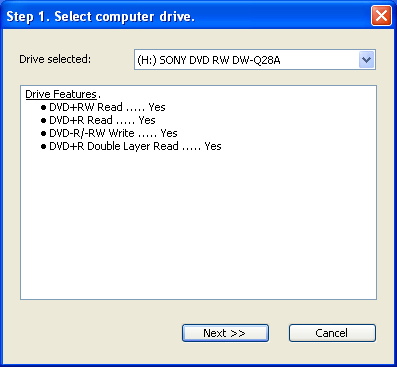
- At the 2nd step, please insert your DVD and click the Next button.
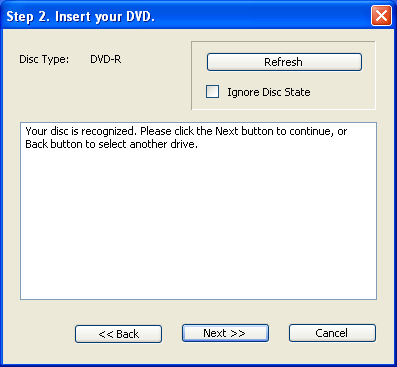
- At the 3rd step, please select DVD video recorder (camcorder or standalone dvd recorder) that placed a video or/and photos on your disc. You can use Any recorder setting and try to scan each of displayed tracks, starting on the track with the highest length.
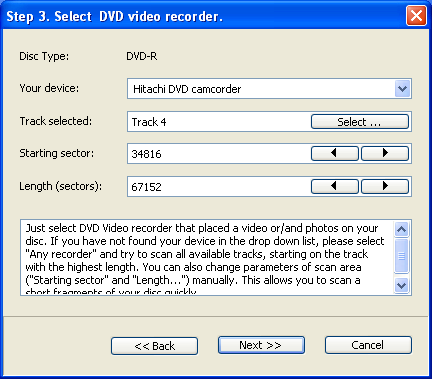
- At the 4th step, just click the Next button if you scan the selected area for the first time.
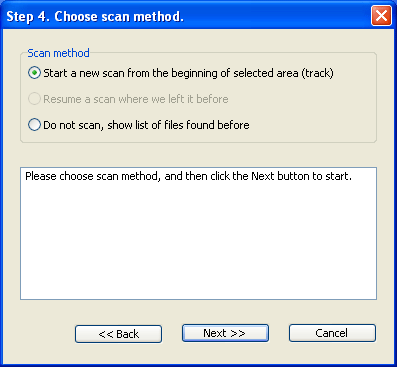
- At the next step, you should see a dialog similar to the one shown here.
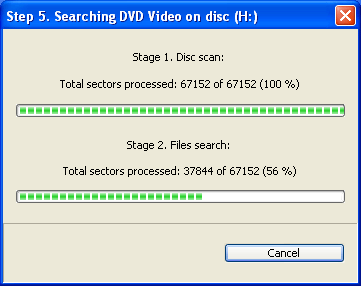
- Finally, try to recover the found video (.vob files) or/and photos with the help of Recover All or Recover Selected commands. You can also try to scan another track, shown at the prior (3rd) step.
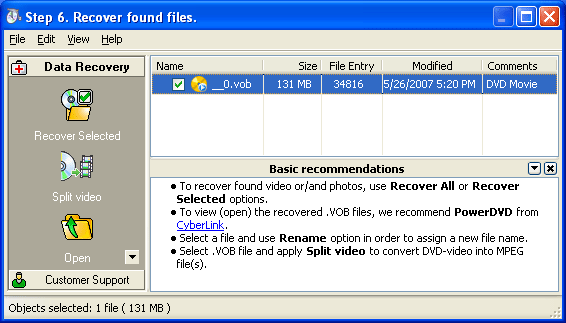
Note. If your mini DVD+RW was re-formatted by camcorder, an additional test is required in order to determine whether the lost video is now accessible or not. Please contact us for more details.
3. Using UDF Reader.
3.1. Recovering VRO files.
You can usually see these video files on the DVD with UDF 2.0 file system. When your dvd recorder or camera writes a video according to DVD-VR standard. If you see UDF 2.0 under File System column in the CDRoller window, try to browse the disc folders, find and recover VRO file directly. Please keep in mind VRO files are often fragmented. If one fragment is seriously damaged or incorrectly recorded by the camera, this can stop all recovery process. A solution is to recover each fragment of video (file extent) separately. Details ...
3.2.
Recovering AVCHD video.
- Can be recommended to find .m2ts files (UDF files) on the non-finalized discs created by AVCHD camcorders.
- Select the Preferences option from the View menu. Uncheck the Detect disc insertion by Windows and Always use a drive capabilities boxes under the Browser tab in the Preferences dialog before you will insert the troubled disc into the drive.
- Insert the "troubled" disc into the drive.
- Click the Preferences option from the View menu again. Select an appropriate option (that depends on model of your device and type of the "troubled" disc) in the Forced Scan list under the UDF Reader tab and click the OK button.
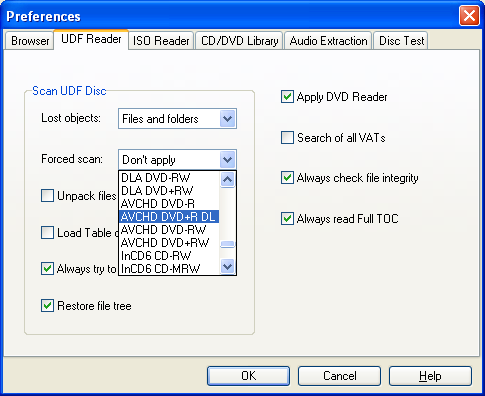
- The program will scan your disc, without using the system data. Further, please follow our Basic Recommendations from built-in adviser. Also, please feel free to contact us if you have any questions regarding dvd video recovery.
4. Viewing VOB files.
To view (play) the recovered VOB files, we recommend PowerDVD from CyberLink.
5. Converting VOB files into MPEG-2 ones.
Our Split video option automatically converts a "raw" DVD-video data (VOB or VRO files) into original MPEG-2 files without loss of quality. In contrast to VOB file, MPEG-2 one can be simply viewed with the help of any DVD-compatible software (player). To activate this option, just click Split Video button in the Side Bar (a left panel of 'Step 6...' dialog mentioned above) and assign the recovered file name in the next dialog. Or, just click Split Video button in the Main ToolBar.
6. Editing recovered video.
To view the recovered video file frame-by-frame and save the selected fragment of video as a new file, you can use our simple Video Editor.
7. Converting MPEG-2 files into MP4 format.
To convert the recovered MPEG-2 files into MP4 ones, you can use our Video Converter.
8. Making a new DVD with recovered video.
Just click Burn button in the Main ToolBar, select Make a new DVD with recovered video and click the Next button in the Start Window dialog.
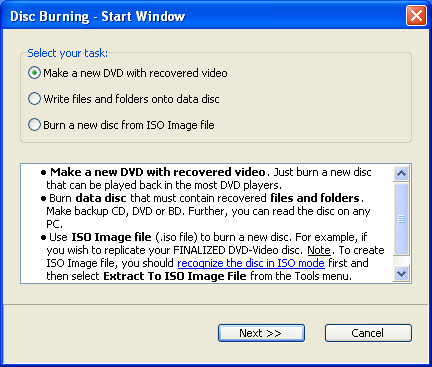
Further, using a simple "step by step" procedure, you select DVD burner (computer DVD drive), add a video (MPG files) into your compilation and, finally, burn a new DVD-video disc that can be played back in the most DVD players. In addition, you can load the recovered MPG or VOB files into your DVD-authoring software, for example: Sony Picture Motion Browser, Windows DVD Maker, Sonic MyDVD, Nero Vision, etc.
9. Viewing JPEG images (photos).
To view the found photos (JPEG files), you can use View Image option. Just select (mark) any JPEG file in the Side Bar (left panel of the window where you see the found files).
10.
Notes.
- To replicate successfully finalized DVD-video disc, you can extract ISO Image file first, and then burn it to a new (blank) disc.
- We do not recommend to use Matsuhita (Panasonic) DVD-RAM UJ-XXXX drives for video recovery from non-finalized DVD-R/-RW/+R discs.
